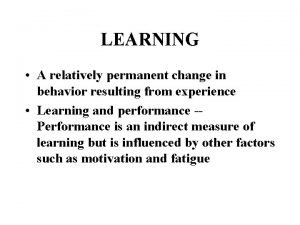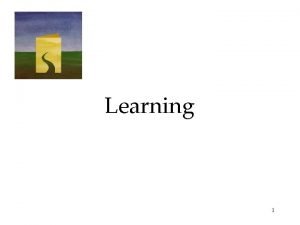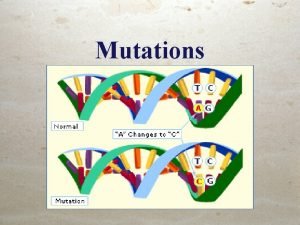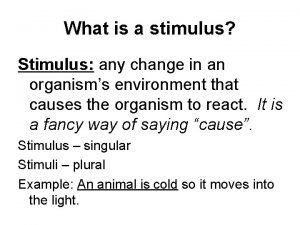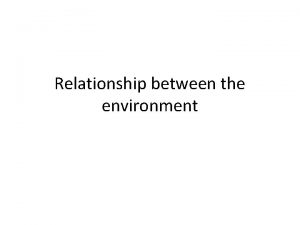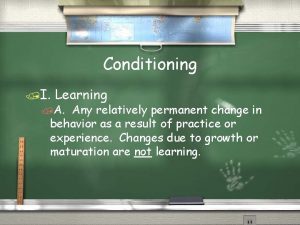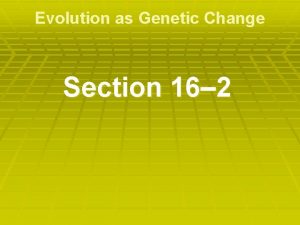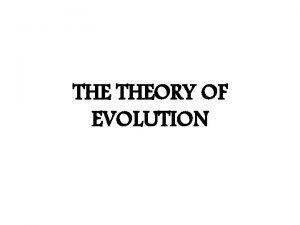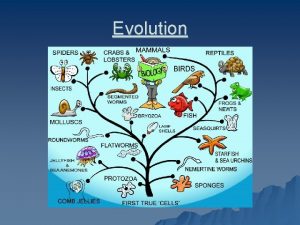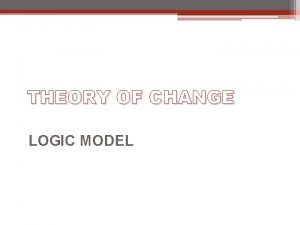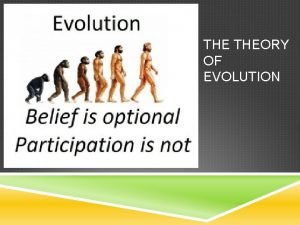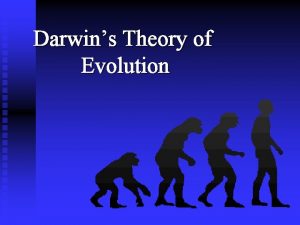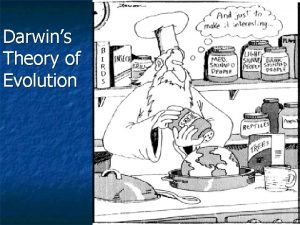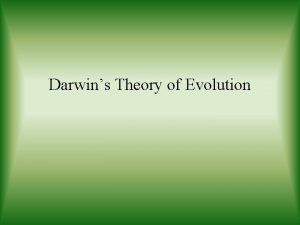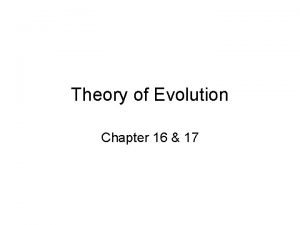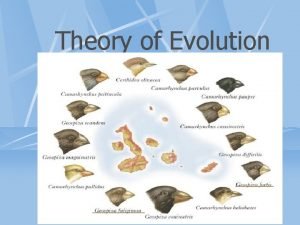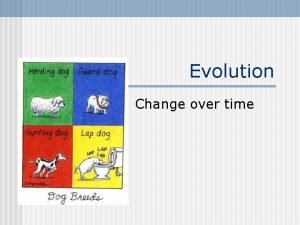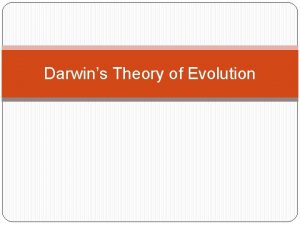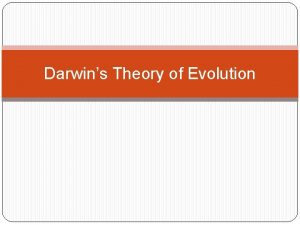The Theory of Evolution Evolution Any change in
































































- Slides: 64

The Theory of Evolution

Evolution Any change in the inherited traits within a population across generations ■ A mechanism for change in populations.

Natural Selection Individuals better adapted to their environment tend to survive and produce more offspring. Natural Selection is a mechanism for changes in populations (evolution).

Natural Selection ■ In nature, organisms produce more offspring than can survive. ■ Struggle for survival

■ In any population, individuals have variations. ■ Variation: Differences between members of the same species

■ ■ ■ Individuals with certain useful variations survive in their environment, They pass those variations to the next generation. “Survival of the Fittest” Fitness: How well an individual passes their genes on to the next generation

■ ■ Over time, offspring with certain variations make up most of the population They may look entirely different from their ancestors.

Natural Selection Individuals better adapted to their environment tend to survive and produce more offspring. Natural Selection is a mechanism for changes in populations (evolution).





The Weak Link of Natural Selection – Genetics (The Modern Synthesis) A major problem in Darwin’s theory was the lack of a mechanism to explain natural selection. How could favorable variations be transmitted to later generations? With the rediscovery of Mendel’s work, the missing link was forged. Darwinian theory supported by genetics is known as the modern synthesis.

Adaptations ■ Any variation that aids in an organism’s chances of survival and reproduction in its environment.

Forms of adaptations ■ Structural ■ Camouflage ■ Mimicry ■ Sexual selection ■ Behavioral

Behavioral Adaptations ■ Behavioral adaptations are things organisms do to survive or reproduce. ■ ■ Migration, hibernation, nocturnal, etc Some types of sexual selection are behavioral.

Behavioral, cont. ■ ■ Gerenuk Antelope (Africa) stand upright to feed on the leaves and shoots of Acacia Trees. This is an example of a behavioral adaptation. Cuckoo Bird Deception

Types of sexual selection: ✓Male to male combat- winners receive mating rights with a female or with a herd of females

Sexual Selection

Structural Adaptations ■ ■ A change in the structure of the species. (How it looks) A porcupine’s quills are an adaptation that keeps predators from approaching.

Sexual Selection ✓Special form of natural selection where species select on specific traits that indicate their choice is a successful mate ✓Usually the female is the “choosier” sex while males are left struggling for the possession of females

Sexual Selection: Mate Choice- specific traits make one mate more attractive than another (ornamentation) Birds of Paradise Jumping Spiders

Camouflage ■ Camouflage enables species to blend with their surroundings.



Mimicry ■ ■ Mimicry is an adaptation that enables one species to resemble another. For example, yellow jacket hornets, honeybees, and many other species of wasps all have harmful stings and similar coloration and behavior. Predators may learn quickly to avoid any organism with their general appearance.

Tree Hopper Mimic Cyphonia clavata (Central America)


Hiding, Camouflage, and Mimicry Video

Co-Evolution: When one species changes and evolves in response to changes in another species

Timing of Evolution Gradualism ■ Evolution occurs slowly over the course of many generations ■ (thousands or millions of years) Punctuated Equilibrium ■ Long periods of little change and then sudden bursts of rapid change ■ Caused by dramatic changes in environment ■ Can happen over several decades (or even less)

High Altitude-Mountains

Desert

Tropical

Convergent vs. Divergent Evolution ■Convergent Evolution: ■Divergent Evolution Organisms that are not related independently develop similar traits. Differences build up in individuals that can lead to the formation of a new species Example: Dolphin fins and Shark fins Example: Elephants and wooly mammoths

Speciation: When one species splits into two species that no longer interbreed and produce fertile offspring Bird Speciation (8 min) Crash Course

Helpful Terms Microevolutionshort period of time, populations Macroevolutiongeologic time, fossil record generations Biodiversitythe variety of life in the world or in a particular habitat or ecosystem

Speciation ■ The evolution of a new species occurs when members of similar populations no longer interbreed to produce fertile offspring within their natural environment. Geographic isolation occurs whenever a physical barrier divides a population.

Geographic isolation can lead to speciation

Homologous Structures ■ Homologous structures can be similar in arrangement, in function, or in both which evolved from some structure in a common ancestor.


Analogous Structures ■ Analogous Structures are when the body parts of organisms that do not have a common evolutionary origin, but are similar in function. ■ For example, insect and bird wings probably evolved separately when their different ancestors adapted independently to similar ways of life.

Analogous Structures

Vestigial Structure ■ vestigial structure—a body structure in a present-day organism that no longer serves its original purpose, but was probably useful to an ancestor, and present-day organism still have them in their body plan for the species.

Examples of Vestigial Structures ■ pelvic bones in the baleen whale ■ tiny snake pelvic and limb bones ■ and the eyes in cave-dwelling salamanders and fish that are completely blind



EX. : Wings in flightless birds

Fossils ■ Fossils are an important source of evolutionary evidence because they provide a record of early life and evolutionary history. ■ https: //www. youtube. com/watch? v=I 2 C-3 Pj. NGok

Fossils Camel Evolution Age Organism Skull and teeth Limb bones Paleocene 65 million years ago Eocene 54 million years ago Oligocene 33 million years ago Miocene 23 million years ago Present

Evidence for Evolution – The Fossil Record

Embryology ■ Scientists have compared similarities in the origin, growth, and development of an embryo. ■ These similarities suggest common ancestry.

Evidence for Evolution - Embryology

Comparing DNA ■ This also provides strong evidence for evolution. ■ Nearly all organisms share some of the same DNA base pairs. ■ The more base pairs that are the same the more alike or related the organisms are.



Genetic Variation ■ ■ Populations, not individuals, evolve. Natural Selection acts on the range of phenotypes of a population.

Mutations ■ ■ ■ Mutations – A form of genetic variation Usually mutations on genes are lethal to an organism. Occasionally a mutation results in a useful variation and that new gene becomes a part of the populations gene pool.

The Evolution of Species • When geographic isolation divides a population of tree frogs, the individuals no longer mate across populations. • Tree frogs are a single population.

The Evolution of Species • The formation of a river may divide the frogs into two populations.

The Evolution of Species • Over time, the divided populations may become two species that may no longer interbreed, even if reunited.

Evidence for Evolution – Evolution Observed Evolution of drug-resistance in HIV

Evolution of pesticide resistance in response to selection.

Evolution ■ The change in populations over time.
 There isn't any pasta
There isn't any pasta Any to any connectivity
Any to any connectivity Seknder
Seknder Relatively permanent means
Relatively permanent means Shaping psychology
Shaping psychology Relatively permanent means
Relatively permanent means Chromosomal mutation vs gene mutation
Chromosomal mutation vs gene mutation Geotropism positive and negative
Geotropism positive and negative Interrelationship between the micro and market environment
Interrelationship between the micro and market environment Learning is relatively permanent change
Learning is relatively permanent change Learning is any relatively permanent change
Learning is any relatively permanent change Section 16-2 evolution as genetic change
Section 16-2 evolution as genetic change Industry evolution and strategic change
Industry evolution and strategic change Model of evolution showing slow change
Model of evolution showing slow change Hát kết hợp bộ gõ cơ thể
Hát kết hợp bộ gõ cơ thể Lp html
Lp html Bổ thể
Bổ thể Tỉ lệ cơ thể trẻ em
Tỉ lệ cơ thể trẻ em Gấu đi như thế nào
Gấu đi như thế nào Chụp tư thế worms-breton
Chụp tư thế worms-breton Bài hát chúa yêu trần thế alleluia
Bài hát chúa yêu trần thế alleluia Môn thể thao bắt đầu bằng chữ f
Môn thể thao bắt đầu bằng chữ f Thế nào là hệ số cao nhất
Thế nào là hệ số cao nhất Các châu lục và đại dương trên thế giới
Các châu lục và đại dương trên thế giới Công của trọng lực
Công của trọng lực Trời xanh đây là của chúng ta thể thơ
Trời xanh đây là của chúng ta thể thơ Cách giải mật thư tọa độ
Cách giải mật thư tọa độ 101012 bằng
101012 bằng độ dài liên kết
độ dài liên kết Các châu lục và đại dương trên thế giới
Các châu lục và đại dương trên thế giới Thơ thất ngôn tứ tuyệt đường luật
Thơ thất ngôn tứ tuyệt đường luật Quá trình desamine hóa có thể tạo ra
Quá trình desamine hóa có thể tạo ra Một số thể thơ truyền thống
Một số thể thơ truyền thống Cái miệng nó xinh thế chỉ nói điều hay thôi
Cái miệng nó xinh thế chỉ nói điều hay thôi Vẽ hình chiếu vuông góc của vật thể sau
Vẽ hình chiếu vuông góc của vật thể sau Thế nào là sự mỏi cơ
Thế nào là sự mỏi cơ đặc điểm cơ thể của người tối cổ
đặc điểm cơ thể của người tối cổ Thế nào là giọng cùng tên
Thế nào là giọng cùng tên Vẽ hình chiếu đứng bằng cạnh của vật thể
Vẽ hình chiếu đứng bằng cạnh của vật thể Tia chieu sa te
Tia chieu sa te Thẻ vin
Thẻ vin đại từ thay thế
đại từ thay thế điện thế nghỉ
điện thế nghỉ Tư thế ngồi viết
Tư thế ngồi viết Diễn thế sinh thái là
Diễn thế sinh thái là Dạng đột biến một nhiễm là
Dạng đột biến một nhiễm là Số.nguyên tố
Số.nguyên tố Tư thế ngồi viết
Tư thế ngồi viết Lời thề hippocrates
Lời thề hippocrates Thiếu nhi thế giới liên hoan
Thiếu nhi thế giới liên hoan ưu thế lai là gì
ưu thế lai là gì Sự nuôi và dạy con của hổ
Sự nuôi và dạy con của hổ Khi nào hổ con có thể sống độc lập
Khi nào hổ con có thể sống độc lập Sơ đồ cơ thể người
Sơ đồ cơ thể người Từ ngữ thể hiện lòng nhân hậu
Từ ngữ thể hiện lòng nhân hậu Thế nào là mạng điện lắp đặt kiểu nổi
Thế nào là mạng điện lắp đặt kiểu nổi Examples of physical changes
Examples of physical changes Physicl change
Physicl change Absolute change and relative change formula
Absolute change and relative change formula Integer numbers
Integer numbers Difference between chemical and physical changes
Difference between chemical and physical changes Change in supply vs change in quantity supplied
Change in supply vs change in quantity supplied Supply and demand curve shifts
Supply and demand curve shifts Enagic comp plan
Enagic comp plan Reactive change is change that
Reactive change is change that




